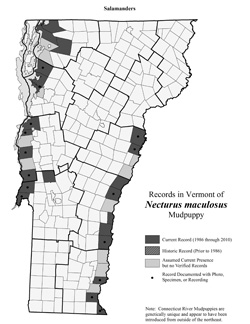Necturus maculosus
Mudpuppy
Identification
The Mudpuppy is our only completely aquatic salamander, and our largest. In Vermont, individuals measuring up to 14 inches long have been reported.
Juvenile Mudpuppies have broad yellowish stripes. As adults they become all brown with black blotches. Their tail is laterally compressed (like a fish) and their snout is broad and squared.
Their eggs are attached one at a time to the underside of rocks or logs.
They are remarkably active during the winter and are occasionally caught by anglers while ice fishing.
Range/Habitat
They live their lives usually near cover at depths of up to 60 feet in permanent bodies of water. They may move upstream or to shorelines to shallower water to lay their eggs.
They are native to Lake Champlain but it is assumed that they were introduced to the Connecticut River watershed.
Status
The Mudpuppy is a is a species of special concern Vermont. This species has a state natural heritage rank of S2 (rare) and has been designated a Species of Greatest Conservation Need (high priority) in Vermont’s Wildlife Action Plan. Please report all sightings of this species in Vermont. Take photos if possible. Even historic sighting information is useful.
More Info
- Necturus maculosus at Animal Diversity website
- Necturus maculosus at Amphibiaweb
- Necturus maculosus at the CARCNET website
- Necturus maculosus in the Vermont Agency of Natural Resources’ Wildlife Action Plan (PDF)
- Necturus maculosus at the Yale Peabody Museum of Natural History website
Species summary written by Kaile Burgess.
In the Media
Howard, Zach. 2011. Mudpuppy salamander fails to make Vermont endangered list . Mother Nature Network (October 28, 2011). Available at http://www.mnn.com/earth-matters/animals/stories/mudpuppy-salamander-fails-to-make-vermont-endangered-list (accessed March 20, 2013).
Johnson, Tim. 2009. Mudpuppies killed off. Burlington Free Press (October 9, 2009), 1C, 8C. Also available as PDF with pictures.
__________. 2009. Lampricide kills hundreds of salamanders in Lamoille River. Times Argus (October 9, 2009). Available as PDF printed from Times Argus site, text-only PDF and with pictures and ads as it appeared online, PDF with pictures (accessed October 16, 2009).


